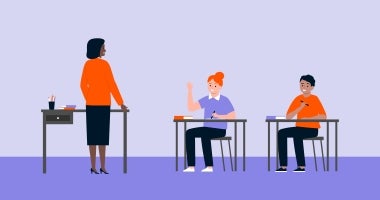
What is explicit teaching and how can it help you be a better educator?
As teachers, we’re all looking for better ways to help students learn.
Explicit teaching is emerging as one of the most efficient strategies for helping students understand and retain more information. Backed by the science of learning, explicit teaching is an engaging, systematic and success-oriented teaching approach.
But what is explicit teaching, and how can you apply it? Here, we examine explicit teaching, its uses and how it can benefit your classroom.
What is explicit teaching?
Explicit teaching, or explicit instruction, is a teaching practice in which teachers directly demonstrate to students what to do and how to do it rather than having students figure it out on their own.
We all know what it’s like when we’re given too much information at one time. Our brains can feel overloaded and switch off. It becomes harder to move information from the working memory to the long-term memory, and learning suffers. The scientific term for this is cognitive overload.
Explicit teaching aims to avoid students' feelings of cognitive overload. It’s an effective learning strategy because it aligns how the brain processes information with learning.
Explicit instruction involves giving students smaller pieces of content and explaining each part so it can help them retain information. The new information scaffolds what students already know, giving them a chance to build on their knowledge more effectively. By connecting with previous knowledge, more information moves into long-term memory.
Here's an example of how it can work:
- At the beginning of each lesson, you define what you’re covering in the lesson. You explain the new concept, what skills are needed, and how it relates to the work they have already done.
- Break each new concept into chunks and go through it step-by-step, using examples and explaining what success looks like.
- You might talk about common misconceptions of the concept and ask what the students know about what they’re learning. You then work through the problem with the class, asking for feedback as you go.
- Finally, when your students are ready to demonstrate their independence, they have time to practise independently. You’re available for additional support and direct instruction when they need it.
Evidence has found that students who receive explicit instruction make greater learning gains than those who do not. For instance, a NSW Education Department analysis found that year 9 students who were given explicit instruction were, on average, 2.4 months ahead in learning compared to those who weren’t. They were more likely to persevere with problems and were more motivated and engaged.
Additionally, Australian high school students who reported receiving explicit teaching practices in English class had higher reading scores than those who didn’t.
Why is explicit teaching important?
Explicit teaching has the advantage of benefiting all students, regardless of their year group and ability level.
The Australian Education Research Organisation reviewed over 328 studies on explicit instruction and found that it is an effective teaching practice in a variety of contexts and subgroups of students.
Studies found:
- Explicit instruction has a positive impact on achievement in mathematics, reading, spelling, problem-solving and science.
- Explicit instruction is effective for primary and secondary students alike.
- Explicit instruction can benefit a broad range of students, from gifted students to those who have learning disabilities.
One study compared explicit and constructivist instruction in teaching subtraction in schools with a high proportion of students from disadvantaged social backgrounds. It found that although all students progressed, those who received explicit teaching performed better.
Explicit teaching can also benefit gifted students who may master concepts more easily. Studies have found that, when they receive explicit guidance, students are more likely to move through at a faster pace and can use what they’ve learned for extended problem-solving and independent learning.
With explicit teaching, students' familiarity with the subject increases over time, and they can use their increasing skills and knowledge to solve challenges.
What are some examples of explicit teaching strategies?
The way explicit teaching can look in practice varies from class to class. However, some common examples of strategies include:
Using effective questioning
Questioning is a key part of explicit teaching. When you ask the students the right questions, you can determine whether they have understood the lesson.
However, teachers need to make sure they’re asking deeper questions that require explanation. The questions need to help the student meaningfully organise the information and provide the answer.
Chunking and sequencing learning
There is a limit to how much the brain can process in the working memory, but there is no known limit to how much long-term memory can be processed. This is called cognitive load theory, and it supports explicit instruction models.
By chunking information, students have the chance to process new information in their working memory and transfer it to their long-term memory. When you give students clearly sequenced pieces of information, they’re more likely to understand it and recall it later.

Connecting learning
Students are more likely to understand and retain information if it’s connected to something they already know. The best lessons are organised around a specific aim to help them contextualise how this new material is related.
For example, you could use mind maps to describe what is already known and how this new knowledge will fit in and connect.
Sharing success criteria
Sharing success criteria helps students understand what achievement will look like in that lesson. It gives them a framework for communicating with their teacher and helps them ask for help when they need it.
You can use success criteria throughout the lesson when you’re checking for understanding, getting feedback from students, and asking students to self-assess their own work.
You might use sentence starters like ‘What I am looking for’ to give students an example of quality work.
Sharing learning intentions
A learning aim or intention states what you expect students to learn in a lesson. You can share it at the beginning and reiterate it throughout to ensure students understand.
Clear communication of learning intentions can help students focus on the key concepts they need to learn.
Learning intentions should be shared with success criteria so students have a target of what they’re expected to achieve.
Gradual release of responsibility
As the lesson progresses, you need to gradually release students of responsibility to practise what they’ve learned independently.
However, this process isn’t linear, and it’s important to move between modelled, guided and independent practice throughout lessons. Students may move forward and back through this process depending on their understanding.
The gradual release of responsibility could include multiple opportunities for students to practise concepts and problem-solve, depending on the challenges. Don’t move too quickly to independent practice without making sure each student is ready.
Using effective feedback
Feedback is most useful when it’s given during the learning and is aligned with the learning intentions and success criteria. The goal of feedback is to help students think about how they can bridge the gap between their current understanding and the success criteria.
Effective feedback can be verbal or written and gives a student a chance to respond and improve. It should give the student an opportunity to act on the advice and improve their work.
It’s important to note that feedback isn’t a mark or a grade. Research has found that when students receive their marks, they often stop learning. Feedback needs to be timely, specific, and ongoing.
Checking for understanding
As a teacher, you need to ensure that all students understand before moving on to modelled, guided and independent practice. Checking for understanding doesn’t just happen at the end of the lesson or by asking if everyone understands. It needs to be ongoing and personalised to ensure that each member of the class has grasped the concept before moving on.
Checking for understanding can be done before and during a lesson. For example, there could be an informal pre-quiz prior to setting the learning objectives to understand existing knowledge.
The success criteria will guide student understanding throughout the lesson using a variety of strategies, including effective questioning.
Master explicit teaching with ECU Online
As a teacher, learning about explicit teaching can unlock a host of positive outcomes for you and your students.
Explicit teaching is one of the key themes covered in ECU Online’s Master of Education (Science of Learning) degree, where you’ll critically engage with contemporary models of high-impact instruction and learn how to transform your teaching practice.
This course is for educators who want more classroom resources to increase learner potential and understanding. It gives you guided and supported practice to improve teaching strategies and student learning.
With our accelerated online degrees, we help you fit study around your life. You will graduate sooner than traditional part-time study and have the option to complete a Master of Education in as little as 16 months while continuing to work full time.
Gain contemporary, research-based strategies to improve learning outcomes with ECU Online’s Master of Education (Science of Learning).
To find out more, reach out to one of our Student Enrolment Advisors on 1300 707 760, email future.student@studyonline.ecu.edu.au or download a brochure.



